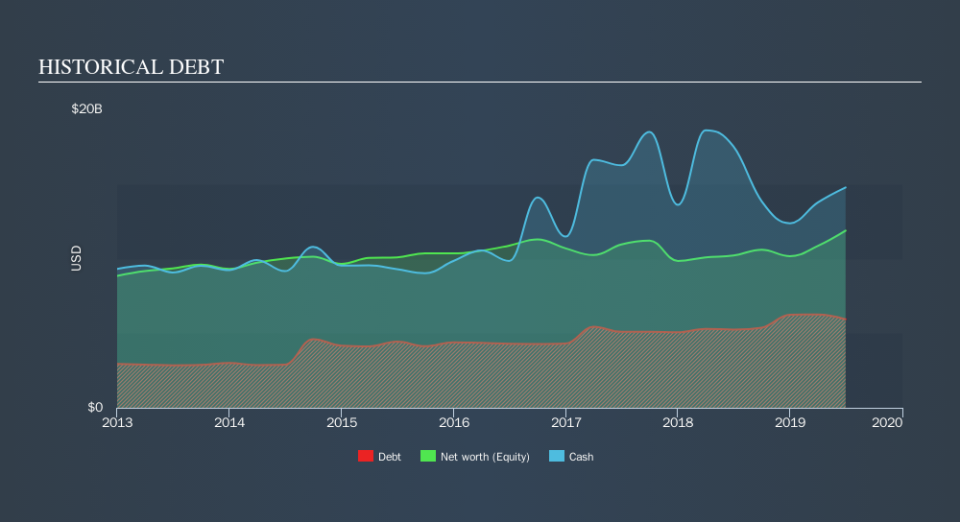Is Humana (NYSE:HUM) Using Too Much Debt?

Howard Marks put it nicely when he said that, rather than worrying about share price volatility, 'The possibility of permanent loss is the risk I worry about... and every practical investor I know worries about. When we think about how risky a company is, we always like to look at its use of debt, since debt overload can lead to ruin. We can see that Humana Inc. (NYSE:HUM) does use debt in its business. But the more important question is: how much risk is that debt creating?
When Is Debt Dangerous?
Debt and other liabilities become risky for a business when it cannot easily fulfill those obligations, either with free cash flow or by raising capital at an attractive price. Part and parcel of capitalism is the process of 'creative destruction' where failed businesses are mercilessly liquidated by their bankers. However, a more usual (but still expensive) situation is where a company must dilute shareholders at a cheap share price simply to get debt under control. Of course, the upside of debt is that it often represents cheap capital, especially when it replaces dilution in a company with the ability to reinvest at high rates of return. When we think about a company's use of debt, we first look at cash and debt together.
See our latest analysis for Humana
How Much Debt Does Humana Carry?
The image below, which you can click on for greater detail, shows that at June 2019 Humana had debt of US$5.93b, up from US$5.25b in one year. But it also has US$14.8b in cash to offset that, meaning it has US$8.84b net cash.
How Healthy Is Humana's Balance Sheet?
We can see from the most recent balance sheet that Humana had liabilities of US$11.5b falling due within a year, and liabilities of US$5.50b due beyond that. On the other hand, it had cash of US$14.8b and US$904.0m worth of receivables due within a year. So it has liabilities totalling US$1.37b more than its cash and near-term receivables, combined.
Given Humana has a humongous market capitalization of US$39.1b, it's hard to believe these liabilities pose much threat. However, we do think it is worth keeping an eye on its balance sheet strength, as it may change over time. Despite its noteworthy liabilities, Humana boasts net cash, so it's fair to say it does not have a heavy debt load!
Fortunately, Humana grew its EBIT by 6.9% in the last year, making that debt load look even more manageable. There's no doubt that we learn most about debt from the balance sheet. But ultimately the future profitability of the business will decide if Humana can strengthen its balance sheet over time. So if you want to see what the professionals think, you might find this free report on analyst profit forecasts to be interesting.
But our final consideration is also important, because a company cannot pay debt with paper profits; it needs cold hard cash. While Humana has net cash on its balance sheet, it's still worth taking a look at its ability to convert earnings before interest and tax (EBIT) to free cash flow, to help us understand how quickly it is building (or eroding) that cash balance. During the last three years, Humana generated free cash flow amounting to a very robust 94% of its EBIT, more than we'd expect. That positions it well to pay down debt if desirable to do so.
Summing up
We could understand if investors are concerned about Humana's liabilities, but we can be reassured by the fact it has has net cash of US$8.84b. The cherry on top was that in converted 94% of that EBIT to free cash flow, bringing in US$306m. So is Humana's debt a risk? It doesn't seem so to us. We'd be very excited to see if Humana insiders have been snapping up shares. If you are too, then click on this link right now to take a (free) peek at our list of reported insider transactions.
At the end of the day, it's often better to focus on companies that are free from net debt. You can access our special list of such companies (all with a track record of profit growth). It's free.
We aim to bring you long-term focused research analysis driven by fundamental data. Note that our analysis may not factor in the latest price-sensitive company announcements or qualitative material.
If you spot an error that warrants correction, please contact the editor at editorial-team@simplywallst.com. This article by Simply Wall St is general in nature. It does not constitute a recommendation to buy or sell any stock, and does not take account of your objectives, or your financial situation. Simply Wall St has no position in the stocks mentioned. Thank you for reading.


